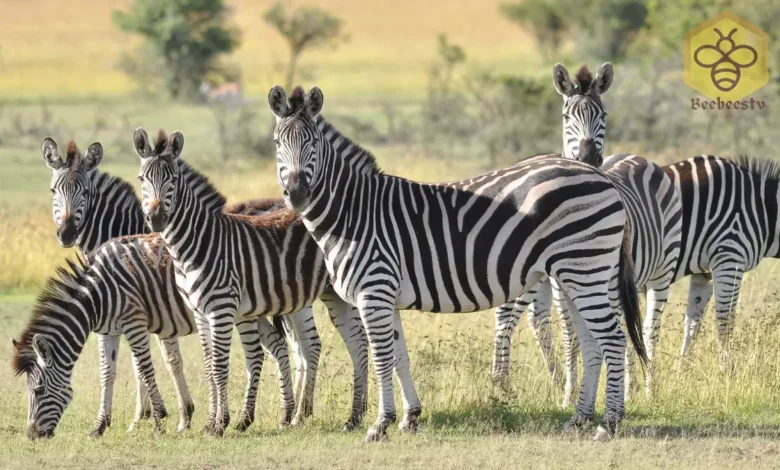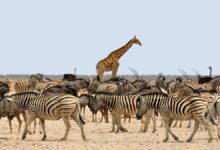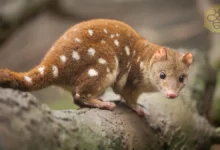Zebras: Black and White Beauty of African Savannah

Zebra: The Striped Icon of the African Savannah
Zebras
Zebras are one of the most recognizable animals in the world, thanks to their unique black and white stripes. These social, herbivorous mammals are native to Africa and have evolved to thrive in a variety of habitats across the continent. With their striking appearance, zebras are not only fascinating to look at but also play a vital role in their ecosystems.
Scientific Name
The scientific name for the zebra depends on the species, but the most common is Equus quagga for the plains zebra.
Common Name
The term “zebra” refers to these iconic striped mammals known for their equine features and wild nature. The name “zebra” is derived from the Portuguese word “zebro,” which referred to a type of wild horse.
Scientific Classification
| Kingdom | Animalia |
| Phylum | Chordata |
| Class | Mammalia |
| Order | Perissodactyla |
| Family | Equidae |
| Genus | Equus |
| Species | Various (including Equus quagga, Equus grevyi, and Equus zebra) |
Types of Zebras
There are three main species of zebras, each with distinct characteristics and habitats:
- Plains Zebra (Equus quagga): The most common species, found in Eastern and Southern Africa. It has broader stripes and some variations, such as the Burchell’s and Grant’s zebra.
- Grevy’s Zebra (Equus grevyi): The largest and most endangered species, located in Northern Kenya and Ethiopia. It features narrow, closely spaced stripes.
- Mountain Zebra (Equus zebra): Found in southwestern Africa, this species has a distinctive dewlap on its throat and slightly narrower stripes than the plains zebra.
Habitat
Zebras inhabit a range of environments across Africa, including:
- Savannas and Grasslands: Plains zebras are most commonly found in open grasslands and savannas, where they graze on a variety of grasses.
- Semi-Deserts: Mountain zebras thrive in rocky and hilly terrain, adapting to limited water sources.
- Dry Shrublands: Grevy’s zebras are found in more arid and semi-desert regions, where they roam in search of water and sparse vegetation.
Physical Characteristics
Zebras are well-adapted to their environments, with physical features that help them survive and thrive.
- Stripes: The black and white stripes are unique to each individual and serve various purposes, such as camouflage, heat regulation, and possibly deterring flies. There are even variations in the stripe patterns among different zebra species.
- Size and Weight: Depending on the species, zebras stand between 4.5 to 5 feet (1.4 to 1.5 meters) at the shoulder and weigh anywhere from 485 to 900 pounds (220 to 400 kilograms).
- Legs and Hooves: Zebras have long, slender legs with solid hooves, making them fast runners capable of reaching speeds of up to 40 miles per hour (65 kilometers per hour).

Diet
Zebras are herbivorous animals that primarily graze on grasses. They also consume other plant materials, including:
- Leaves
- Shrubs
- Bark
Zebras’ digestive systems are well-adapted for processing a fibrous diet, allowing them to extract nutrients from tough grasses that many other herbivores avoid. They often graze for hours each day, keeping them on the move in search of fresh vegetation.
Predators and Threats
Zebras face various predators and threats in the wild, including:
- Predators: Lions, hyenas, cheetahs, and wild dogs are the main predators that hunt zebras, usually targeting the young, weak, or injured members of the herd.
- Human Activity: Habitat loss due to agricultural expansion, poaching, and competition for water resources poses significant threats to zebra populations.
- Climate Change: Changing weather patterns can affect the availability of water and grazing lands, further threatening their survival.
Reproduction, Babies, and Lifespan
Zebra have a social structure that plays a crucial role in their reproduction and care of the young.
- Mating Season: Zebra breed throughout the year, although in some regions, their peak mating seasons may coincide with rainfall and the availability of fresh grasses.
- Gestation Period: The gestation period lasts approximately 12 to 14 months, resulting in the birth of a single foal.
- Caring for the Young: Zebra foals can stand and run within a few hours after birth, allowing them to keep up with the herd for protection. The mother nurses the foal for up to a year, though foals start grazing at a few weeks old.
- Lifespan: In the wild, zebras typically live 20 to 25 years, while in captivity, they can live up to 30 years due to better care and lack of predators.
Population
The population status of zebra varies by species:
- Plains Zebra: The most numerous, with an estimated population of over 500,000 individuals.
- Grevy’s Zebra: Endangered, with fewer than 2,500 individuals remaining due to habitat loss and poaching.
- Mountain Zebra: Classified as vulnerable, with some recovery efforts in place to protect and increase their numbers.
Behavior and Lifestyle
Zebras are social animals, living in structured groups for safety and companionship.
- Herd Structure: Plains zebras form family groups known as harems, which consist of one stallion, several mares, and their offspring. Larger herds may form during migration or when resources are abundant.
- Communication: They communicate through vocalizations such as barking, braying, and snorting. They also use body language, including ear and tail movements, to convey mood and intentions.
- Migration: Some zebra populations undertake long migrations in search of food and water, often traveling hundreds of miles and facing numerous dangers along the way.
Ecological Role
Zebra play a significant role in maintaining the balance of their ecosystems.
- Grazing: As grazers, zebras help to manage grassland growth and promote new plant growth. Their grazing patterns can also create opportunities for other herbivores that prefer shorter grasses.
- Seed Dispersal: By feeding on various plant species, zebras help disperse seeds across the landscape, contributing to plant diversity.
FAQs About Zebras
- Why do zebra have stripes?
While the exact reason for zebra stripes remains debated, theories suggest they help with camouflage, regulate body temperature, or deteriting flies. - Are zebras related to horses?
Yes, they are in the same genus (Equus) as horses and donkeys. They share a common ancestor but have distinct adaptations. - How fast can zebras run?
They can run at speeds of up to 40 mph (65 km/h), which helps them escape predators. - Do zebra migrate?
Some zebra populations do migrate, particularly in East Africa, where they travel long distances to find fresh grazing lands and water. - How long do zebras live?
In the wild, they live around 20 to 25 years, while in captivity, they can reach up to 30 years.
Conclusion
Zebras are more than just iconic striped animals of the African savannah; they are vital components of their ecosystems. Their unique physical traits, social behavior, and ecological contributions make them an essential species for the health of grassland and savannah ecosystems. However, the threats they face, such as habitat loss and poaching, underscore the need for continued conservation efforts. By protecting zebras and their habitats, we also preserve the biodiversity and balance of African landscapes. These beautiful and resilient creatures deserve to thrive in their natural environments for generations to come.


